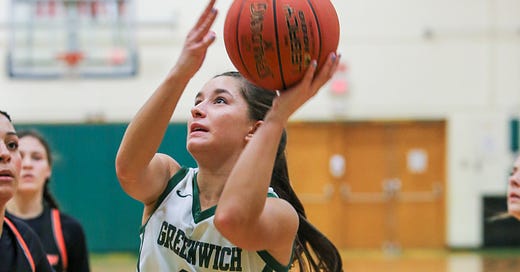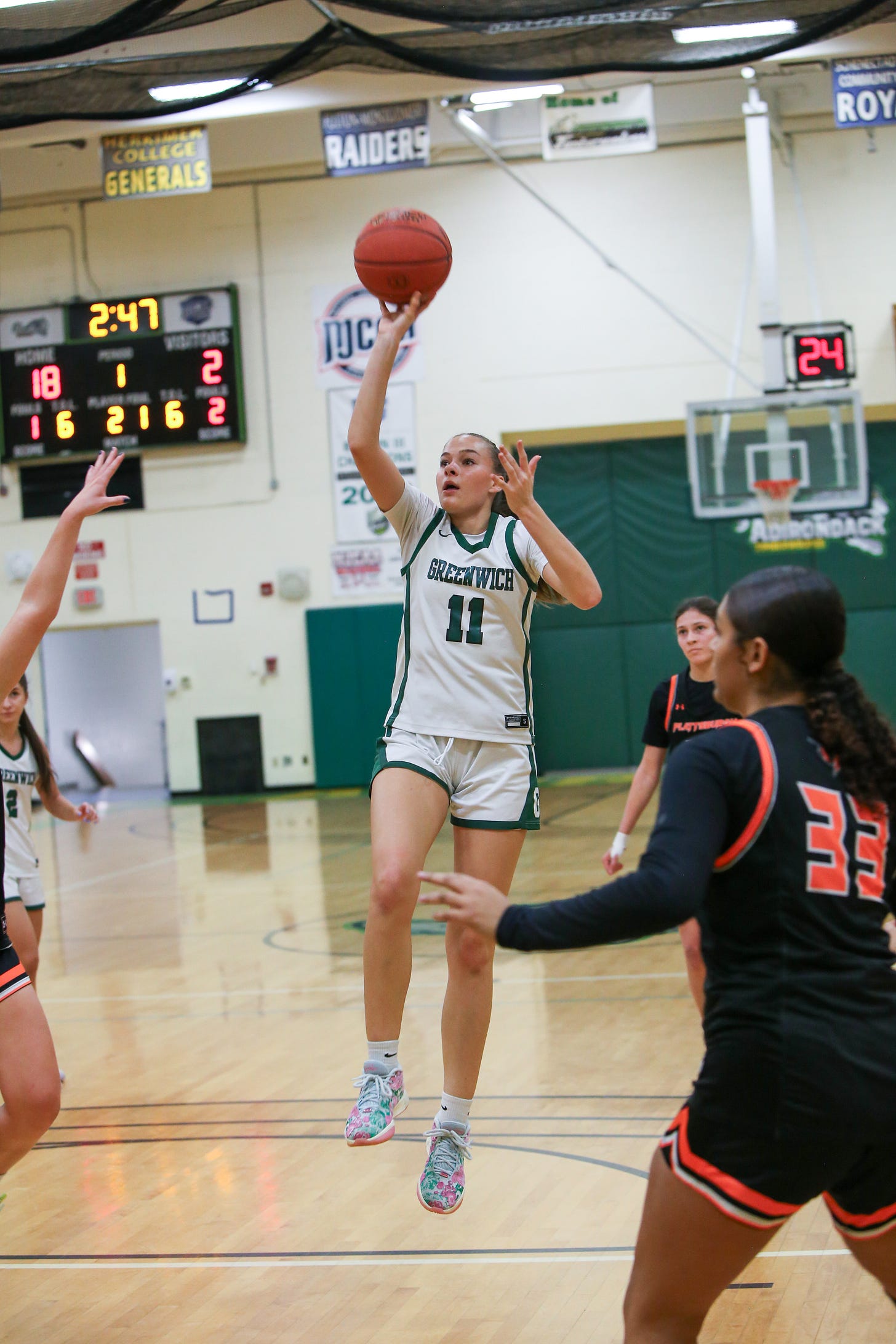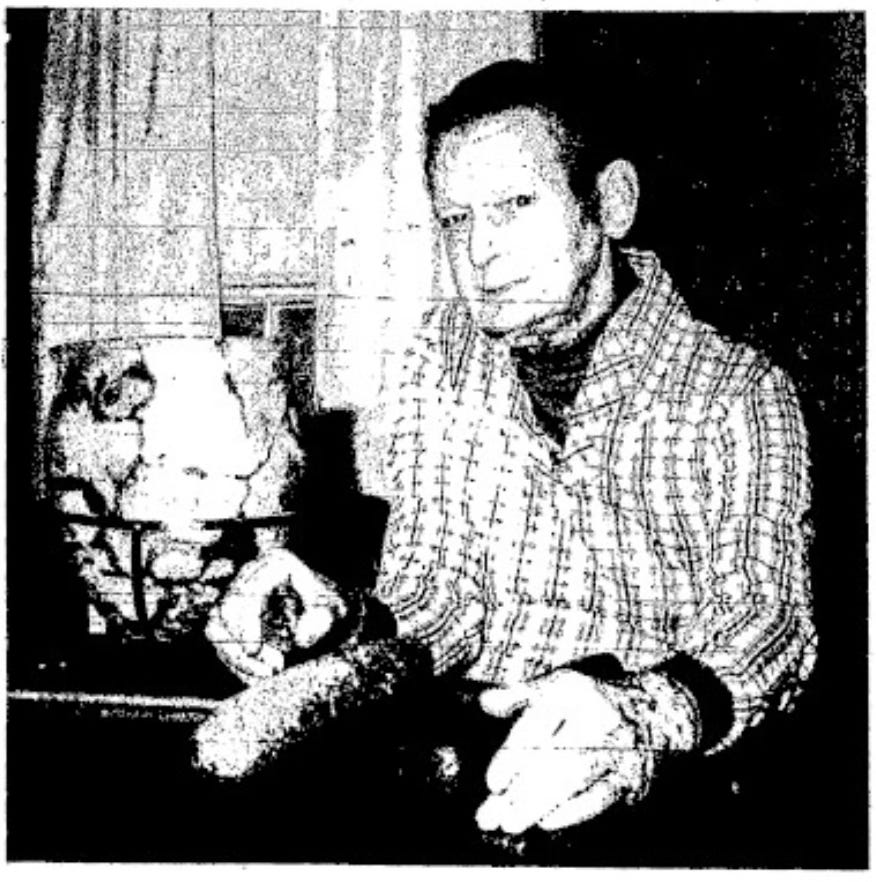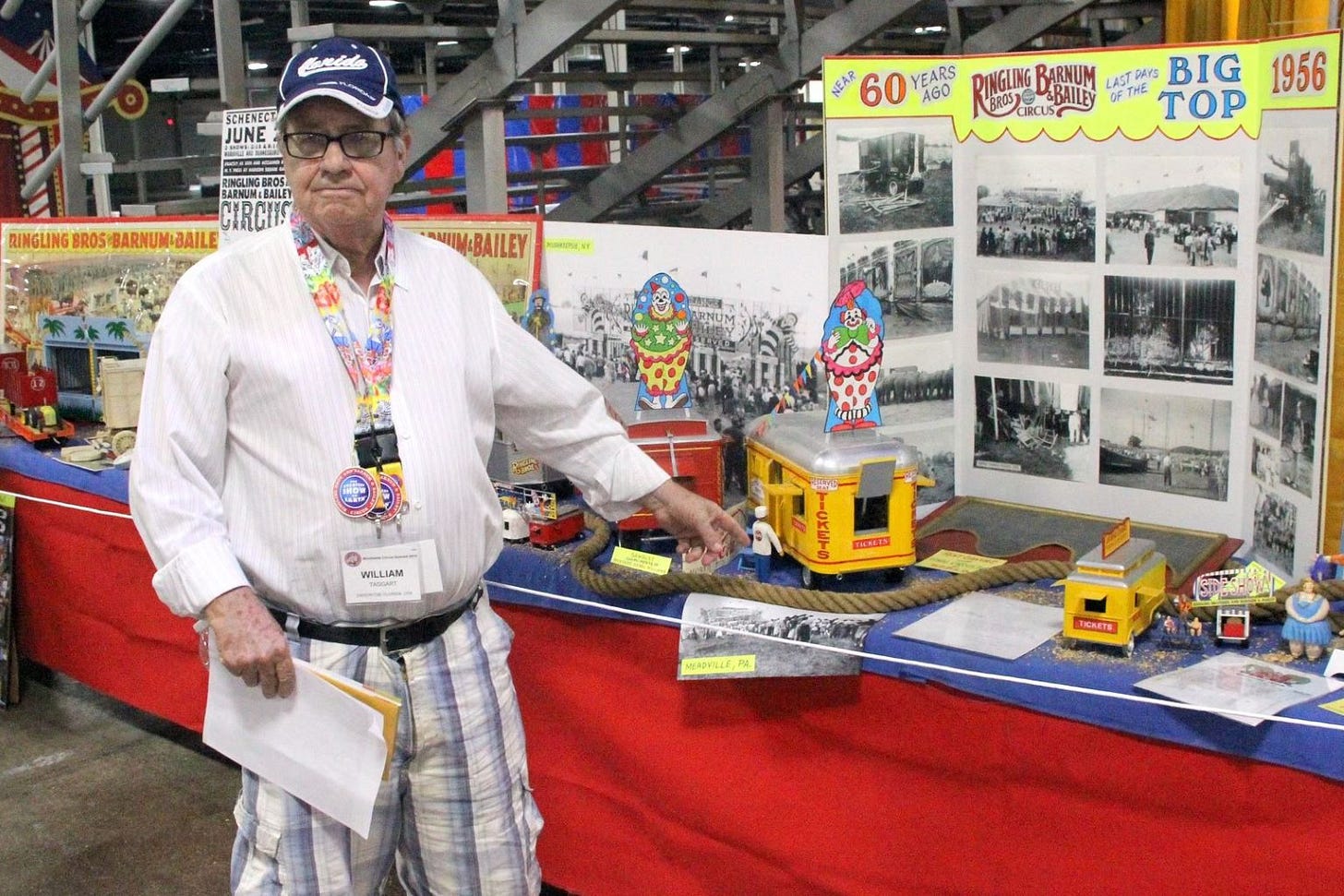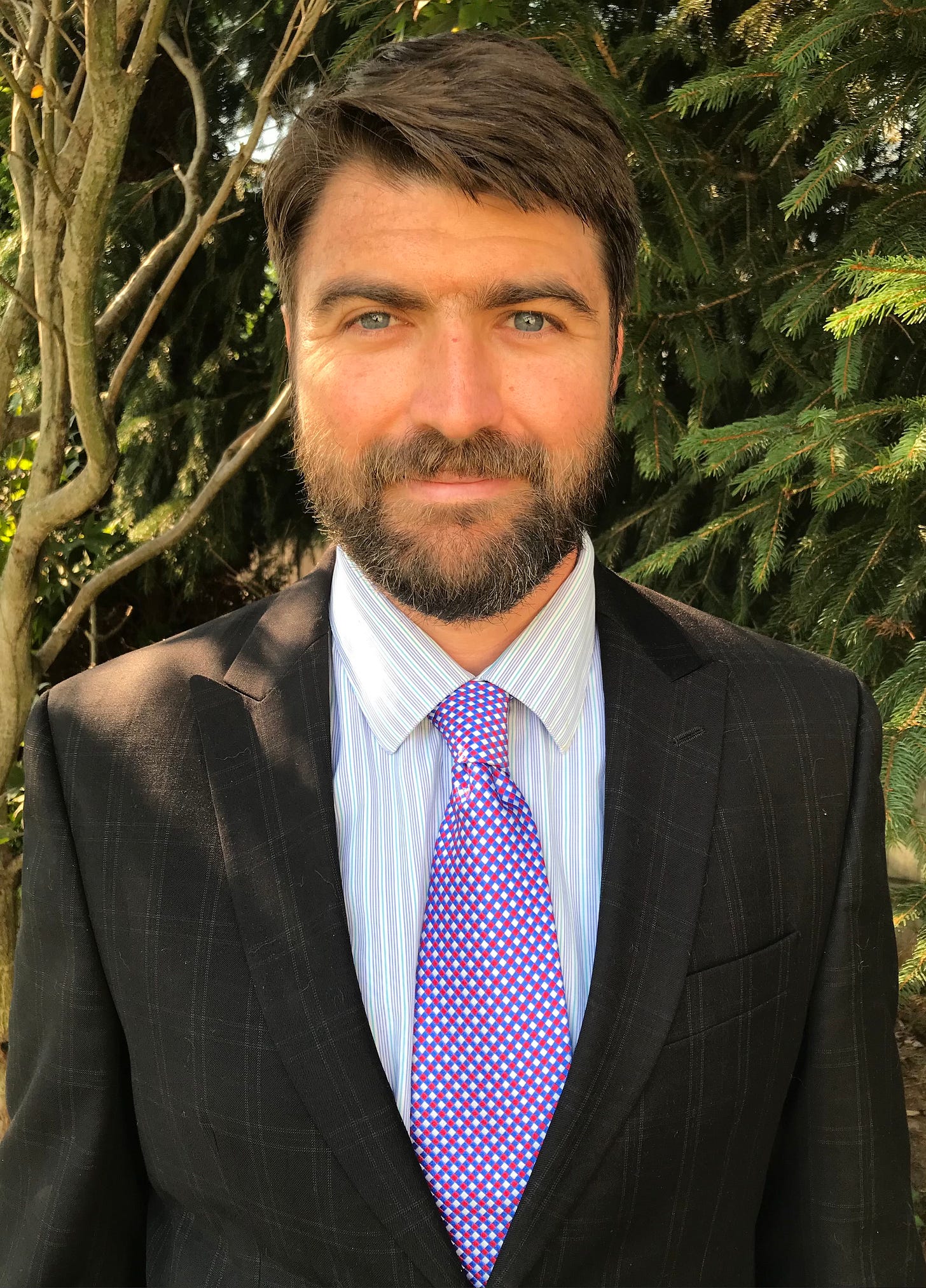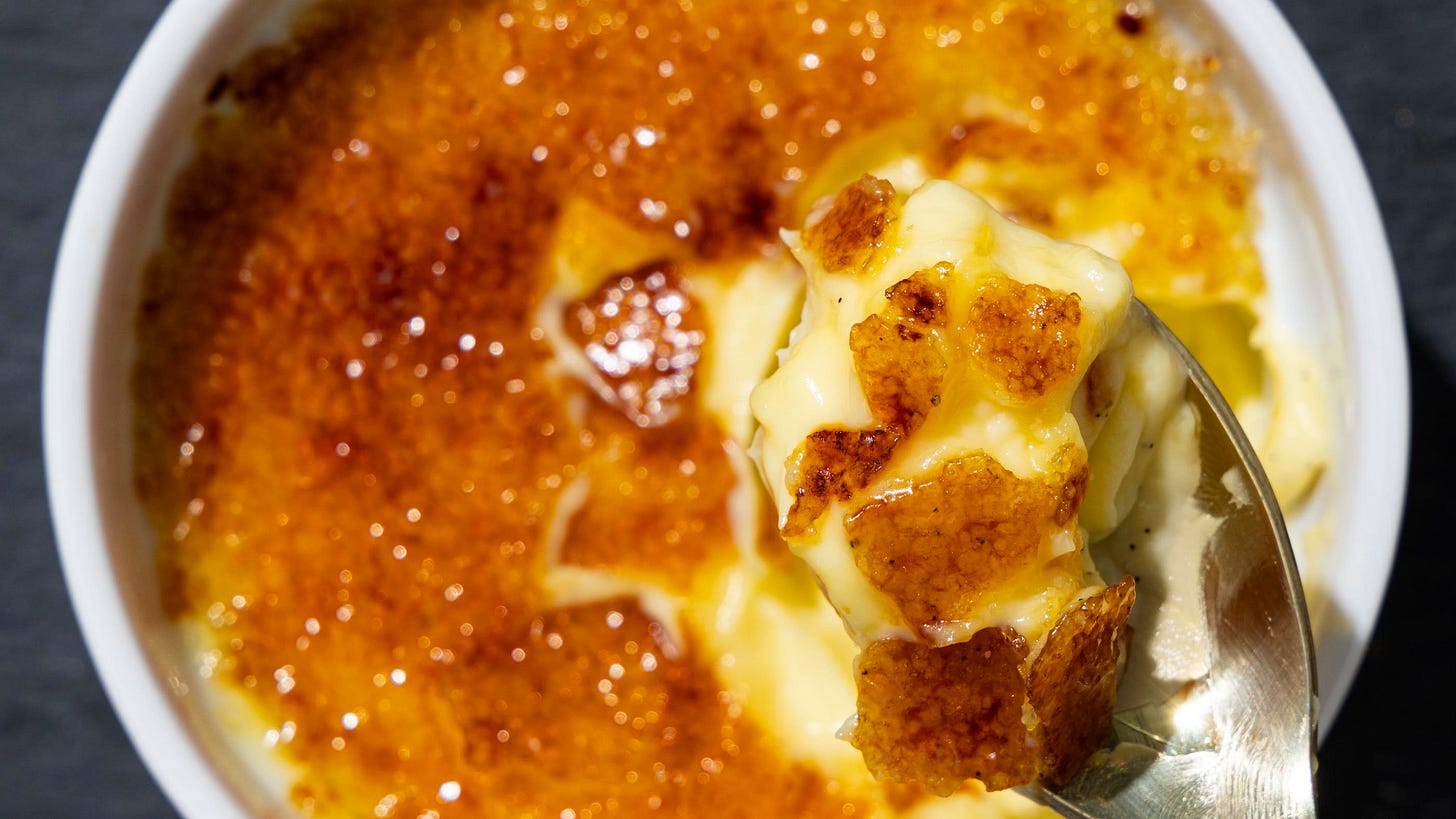The Sunday Paper Edition: Sports, Obituary, Through the Decades, Recipe, Editorial Cartoons, More!
Our jam-packed free e-edition!
Happy Sunday.
We’re expected to get some snowfall starting in the late afternoon or early evening, and it may stretch into Martin Luther King, Jr. Day on Monday. At least students and most workers will have the day off. Thanks in advance to our hardworking snow plow crews. They won’t have the day off and don’t always get enough credit, but do a great job at helping keep our roads safe.
Now, let’s put today’s Sunday Paper Edition into sections…
The Sports Page
Greenwich girls basketball still perfect, No. 2 in state
The Lady Witches faced off against Section 7's Plattsburgh yesterday at Adirondack Community College, securing a decisive victory with a score of 66-30.
Brooke Kuzmich led Greenwich with 19 points, while Bailee Wolfe contributed 18 points. Olivia Davis added 11 points, Grace Autiello chipped in 10, and Riley Brophy rounded out the scoring with 8 points. With this win, Greenwich improved to 13-0 and is currently ranked No. 2 in New York Class C. They are set to take on 10-2 Class A Peru today at 2:30 PM at ACC.
Find more photos from the game on our Facebook page.
Salem-Cambridge wrestling also perfect
Salem-Cambridge wrestlers Ethan Adams, Isaiah Lohret, and Camden Hill were honored at the Salem home meet on Wednesday, January 15th for Senior Night. Coach Frank Fronhofer II’s team faced the Warrensburg-Lake George squad, culminating with an impressive final score of 51 to 21 over the visitors.
The Salem–Cambridge Boys Wrestling team (11-0) will compete in the January 21 Section II dual-meet state qualifying matches. The Section II, Division II semifinals will be held at Cobleskill-Richmondville beginning with the semi-final matches starting at 5pm. Going into the matches as the No. 2 seed, Salem-Cambridge will face No. 3 seed Coxsackie-Athens. Winners of the semi-final matches move onto a 6:30pm face-off. Other Section II qualifiers’ matches on January 21 include top-seed Cobleskill facing No. 4 seed Hudson Falls.
The winning teams in the January 21 qualifying matches then head to the State Dual Meet Championships on February 1 at Onondaga Community College’s SRC Arena in Syracuse. —Jan Baxter
Through the Decades
From The Journal & Press
50 Years Ago
January 23, 1975
This area is rich in Indian artifacts, says Mr. Stevens
There were Indians in this area as early as 9000 years ago, says Fred Stevens of Greenwich, and he has the relics to prove it.
Mr. Stevens has been an amateur archaeologist for 17 years; in that time he has found hundreds of Indian artifacts, including pot fragments, tools, and pipes. Each item that he discovered, says Mr. Stevens, was within a 10 mile radius of Greenwich.
Four sites in the area have proven particularly rich in historical evidence for the ambitious digger: Winney Island in Grangerville, the west side of the Hudson in Fort Miller, behind the Schuyler mansion, where Fish Creek flows into the Hudson, and at Clarks Mills, where the Battenkill joins the Hudson.
It was at the sites where Mr. Stevens uncovered the items that make up his extensive collection of Iroquois and Algonquin artifacts. In the above picture, Mr. Stevens is holding a projectile point that he estimates to be 9000 years old. It is his oldest piece. Carbon dating is used to estimate the age of the things he finds.
The pot to the left of Mr. Stevens is about 1000 years old. He found the pot in 86 pieces and glued them together to show what it once looked like. Also, in the picture, in front of Mr. Stevens, are two stone pestles, once used by Indians for grinding acorns or grain.
Mr. Stevens got started in archaeology because his son was interested in it, in 1958. One day, Mr. Stevens noticed some dirt that a neighbor had had delivered to use as fill. The dirt had rocks in it that had been cracked by fire, said Mr. Stevens, so he figured there were more clues to the past in the ground from which the dirt had been taken. So he investigated. This led him to the Schuyler mansion site, where he found the pot which is in the picture. He had to dig 42 inches down to find it. Evidence of several different cultures can be found at that one site, says Mr. Stevens.
The best place to find artifacts, he says, is near the rivers. That is where the Indians settled. The area along the Hudson, between where the Battenkill and Fish Creek joined the river, says Mr. Stevens, is known as the Indians crossroads.
Scalpers, drills, knives, picks, and projectile points have been turned up in the area.
Mr. Stevens emphasizes that not all projectile points are arrowheads. As a matter of fact, he says, few of the points he has found were arrowheads. Most of them were used for spears and javelins. Arrows are a relatively new invention, he says, probably about 2000 years old.
Decorated pottery is a common find in this area. In his collection, Mr. Stevens has pots showing the advancement of the Indians’ pottery-making ability over the ages.
None of the pots he finds are whole, however, this is partly due to the fact that the pressure of the dirt breaks the dishes, but also because of an old Indian custom of “killing” a pot once it has served its owner. The Indians believed that the pots had evil spirits in them, says Mr. Stevens. This was actually because they never washed the pots, he says, so eventually they began to be a source of illness. But for one reason or another, the Indians broke the pot after using them for a while.
Also, says Mr. Stevens, they would break the tip off an arrow or spear point that had been used to kill an animal.
When the Indians buried a dead man, he says, some of the deceased belongings would be buried with the body. Everything else would be destroyed. Mr. Stevens finds no evidence at the Indians accumulated wealth.
Occasionally he has discovered Indian graves, but he leaves them undisturbed. As far as artifacts, he collects them only because they interest him. Mr. Steven says he would not sell any of the pieces he has discovered.
Obituary
Remembering Bill Taggart
By William “Al” Cormier, Salem Historian
Special to Journal & Press
On December 24, at about 10 AM at Palm Gardens, Sun City, FL, 94-year-old Bill Taggart passed away. The announcement came to me from Wes Fields, one of Bill’s close friends.
During Bill’s life, he made many friends in his chosen professions, professions exciting and gratifying. In the fall of 1953, as part of his Hiram College curriculum, he attended an American University Washington semester in Washington, DC. It was there that Bill “ran away with the circus” that summer. He was hired to work for the Ringling Bros. and Barnum & Bailey Circus, taking care of show horses and working the ticket booth from 1953 to 1956.
His love for horses began as a child growing up in Clyde, NY. Wes Fields recalls Bill saying that as a boy he would ride his horse to deliver newspapers. Later, as an adult, he moved to Salem with his mother to live with his aunts and, Windsong, his last horse. Windsong was a Morgan horse that would carry him and neighbors throughout the streets of Salem in summer and in winter in his “two wheel jog cart” or his Frank Wright Studebaker Dealer Salem-built sleigh. Bill’s personality and graciousness made easy friendships coated with excitement and the unexpected.
The lure of circus life never left Bill, even though the outdoor big top circus had shut down on July 16, 1956 in Pittsburg due to complaints by animal rights advocates and Teamster Union pickets. It was here, in his assigned “Yellow Wagon,” that Bill sold the very last ticket for the last “under the big top” outdoor circus show. His story is told in “The Last Ticket” in the Bandwagon magazine, No. 1 2023. Ringling Bros. and Barnum and Bailey Circus would now perform indoor shows only. Bill, however, continued to work with Ringling Bros. in the large indoor arenas and then smaller circuses such as Clyde Beatty-Cole Bros. Circus, and Cristiani Circus.
When he graduated from Hiram College, Bill took a teaching job in Savannah, NY near his home in Clyde and then, moving to Salem, he took a job teaching in Granville. It was here his love for honesty and righteous causes surfaced. He got the Granville Lions Club to sponsor Pete Seeger, and the Granville Sentinel newspaper promoted the March 29, 1967 concert. Seeger, despite being black-listed because of his political beliefs, drew a large crowd to the concert that was a rousing success.
In 1968, Bill managed Don McLean as the Hudson River Troubadour, and that summer the Salem Rotary Club sponsored McLean’s concert. Orchestrated by Bill, McLean participated in the July 4 parade and sang in concert on July 5 at the Salem carnival grounds. That fall Bill was asked by Pete Seeger to take a fund-raising job promoting the Hudson River Clearwater Sloop Inc. He helped raise thousands of dollars toward the estimated cost of $100,000 to build the boat, and, with Peter Seeger’s leadership, affected the start of the Hudson River clean-up.
Bill left a legacy of circus life. During his employment with Ringling Bros. he took 8mm films of the circus acts and the performers in and out of the three rings. The film is now in the archives of the Ringling Museum in Sarasota, Florida. His friendship with Chris Berry, VP of the Historical Society and Associate Editor of Bandwagon, led to Bill’s detailed stories of his experiences with the circus being published in Bandwagon, The Journal of the Historical Society. Upon Bill’s death, Circus History Alive! created a “Zoom Big Top” tribute to him, including a recording of VP Chris Berry’s interview with him, made only a couple of weeks before Bill died.
His friends such as Wes Fields, Bill’s Lyndhurst intern, Chris Berry, Pete Seeger, Don McLean, members of the notable Stephen Rockefeller family, and, of course, his Salem and Granville friends, whom he never forgot, gave him continued support. With his pet dog, Bill made annual summer trips to Salem and Granville to renew friendships. Granville Attorney John Winn said, “Bill was an inspiring teacher, who loved folk music.” Former Granville student, Paul Manchester, said, “Bill was the most interesting and inspiring person” he’d ever met.” Jan Coffinger Baxter, current editor of the Salem Press, recalled that when responding to her FaceBook posts, Bill called her “Salem-girl-Jan” and spoke of his abiding love for Salem. Bill’s endearments were genuine and his friendships lasting. We thank him for being a gentleman and for sharing his adventures. His memory will remain with us always.
The Business Page
Supporting local artists
Green Art Supply recently announced the opening of its retail store as a premier destination for artists and craft enthusiasts. Dedicated to sustainability and creativity, Green Art Supply offers an innovative way to explore and access art materials while supporting local artisans and the environment. After operating successfully online for one year, we are excited to announce the opening of our brick-and-mortar store, providing a physical space for the creative community and conveniently located at 97 Main St in Greenwich.
The New Store Offers:
• New & Gently Used Art Materials: Whether you’re a professional artist or a hobbyist, our collection of high-quality, gently used, and new art supplies provides an affordable and sustainable way to stock your studio.
• Local, Handcrafted Items: Celebrate the creativity of local makers with a selection of unique, handcrafted items that bring art into everyday life.
• Art & Craft Classes: Unlock your creativity with engaging workshops led by experienced artists. From beginners to seasoned creators, there’s something for everyone.
The Mission: Green Art Supply was founded with a vision to create a sustainable art community that values creativity, reduces waste, and supports local artisans. By promoting the reuse of materials and offering eco-friendly options, we aim to:
• Reduce waste by giving art materials a second life.
• Support the local art community.
• Offer affordable, high-quality supplies.
• Be part of a movement that combines creativity with sustainability.
“At Green Art Supply, we believe art has the power to change the world. By creating responsibly and fostering community, we can make a lasting impact,” said Chris Levy, founder of Green Art Supply.
For more information, visit GreenArtSupply.com or sign up for their newsletter to stay updated on classes, events, and new arrivals.
The Arts & Entertainment Page
The history of the Adirondack vacation
The Saratoga County History Center (SCHC) at Brookside Museum announces a virtual presentation by Connor Williams on “Greetings from the Great Camps: The History of the Adirondack Vacation.” This will be the 26th presentation in the Center’s popular speaker series “Experts Next Door” and will take place at 7pm on Thursday, January 23rd through Zoom.
In 1850, the Adirondack region was a blank spot on the map, largely unorganized and uncharted. But, by 1900, the Adirondacks hosted elaborate summer estates for the wealthiest families in America: Vanderbilts, Rockefellers, Carnegies, Whitneys and Morgans. Thomas Edison and Albert Einstein summered and sailed on the same mountain lake. Adirondacks were a destination. How did this happen, and why?
Join Dr. Connor Williams, scholar, teacher and the historian at Great Camp Sagamore (where he directs their history programming) as he answers these questions, and discusses how environmentalism, opulence, industry, inequality, architecture and nature all intersected to produce the Adirondack Park (and the Adirondack vacations) we still connect to today.
The event is open to the public. It is free for SCHC members, and $5 for non-members. Pre-registration is required through the website www.brooksidemuseum.org.
The Food Page
We have the keys to the perfect creme brulee
By Dawn Yanagihara
America's Test Kitchen
Special to Journal & Press
With a lot of testing, we discovered the keys to the perfect creme brulee recipe: lots of yolks for richness, turbinado sugar for a crunchy crust, an instant-read thermometer for judging the custard’s doneness, and a final chill for the best texture.
Classic Creme Brulee
Serves 8
1 vanilla bean
4 cups heavy cream
2/3 cup granulated sugar
Pinch table salt
12 large egg yolks
8 teaspoons turbinado sugar or Demerara sugar
1. Adjust oven rack to lower-middle position and heat oven to 300 F.
2. Cut vanilla bean in half lengthwise. Using the tip of a paring knife, scrape out seeds. Combine vanilla bean and seeds, 2 cups cream, 2/3 cup granulated sugar, and a pinch of salt in a medium saucepan. Bring cream mixture to boil over medium heat, stirring occasionally to dissolve sugar. Off heat, let steep for 15 minutes.
3. Meanwhile, place a dish towel in the bottom of a large baking dish or roasting pan; set eight 6-ounce ramekins on towel. Bring a kettle of water to boil.
4. After cream mixture has steeped, stir in remaining 2 cups cream. Whisk egg yolks in a large bowl until uniform. Whisk about 1 cup cream mixture into yolks until combined; repeat with another 1 cup cream mixture. Add remaining cream mixture and whisk until evenly colored and thoroughly combined. Strain mixture through fine-mesh strainer into a large bowl; discard solids in strainer. Divide mixture evenly among ramekins.
5. Set baking dish on oven rack. Taking care not to splash water into ramekins, pour enough boiling water into dish to reach two-thirds up sides of ramekins. Bake until centers of custards are just barely set and register 170 to 175 degrees, 30 to 35 minutes, checking temperature about five minutes before recommended minimum time.
6. Transfer ramekins to wire rack and let cool completely, about two hours. Set ramekins on baking sheet, cover tightly with plastic wrap, and refrigerate until cold, at least four hours.
7. Uncover ramekins; if condensation has collected on custards, blot moisture from tops of custards with paper towel. Sprinkle each with about 1 teaspoon turbinado sugar; tilt and tap each ramekin to distribute sugar evenly, dumping out excess sugar. Ignite torch and caramelize sugar, keeping torch flame two inches above sugar and slowly sweeping flame across sugar, starting at perimeter and moving toward middle, until sugar is bubbling and deep golden brown. Refrigerate ramekins, uncovered, to rechill, 30 to 45 minutes; serve.
And Now for the (Political) Cartoons…
Drew Sheneman
Joel Pett
Scott Stantis
Dana Summers
And that’s all for today — wasn’t that enough? Please consider becoming a paid subscriber to this newsletter if you like this kind of stuff!


